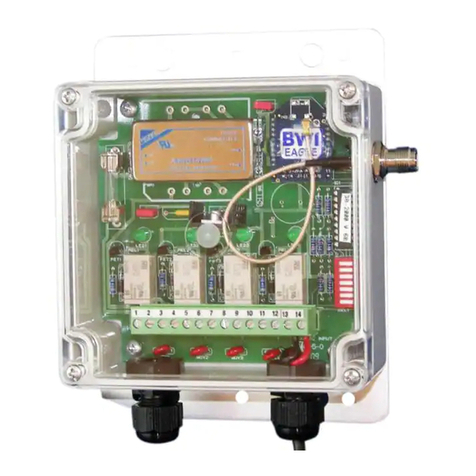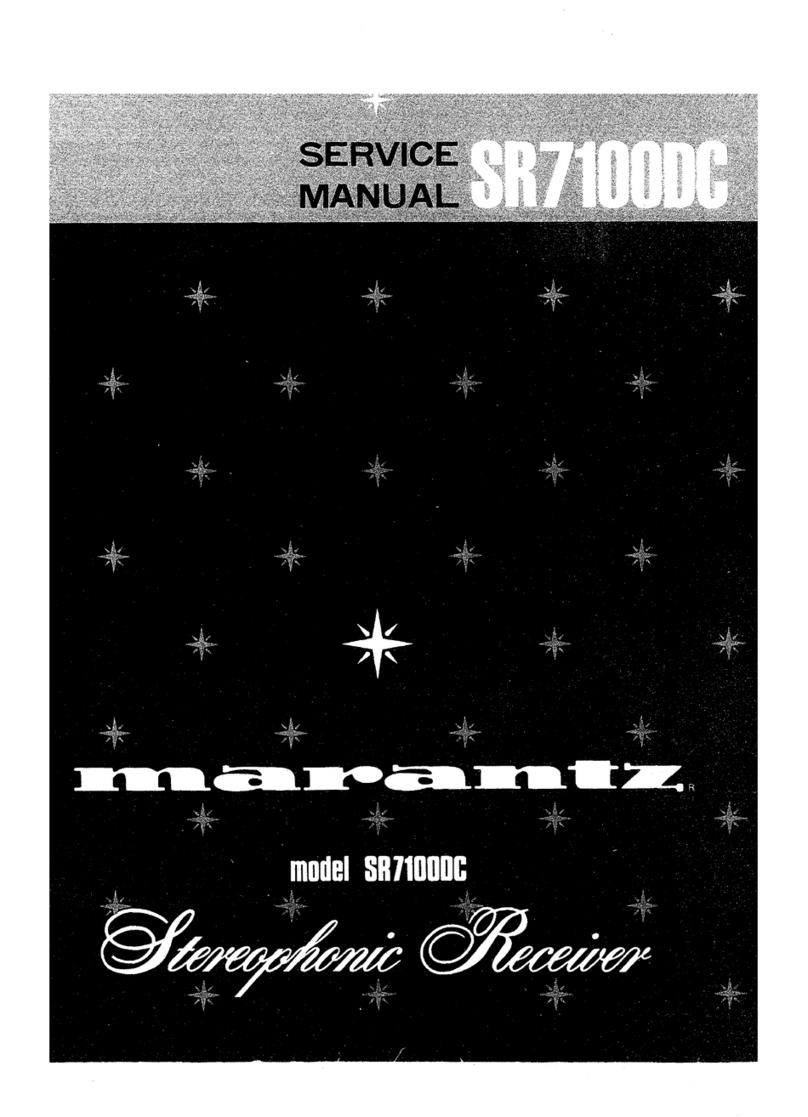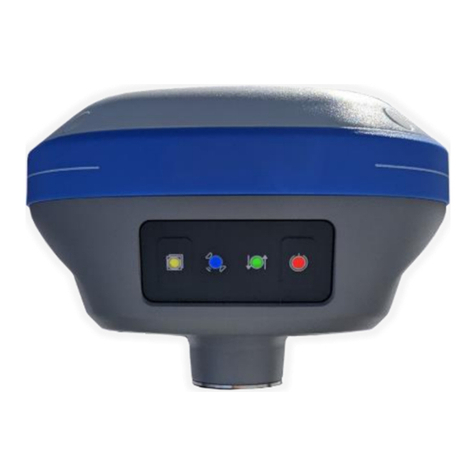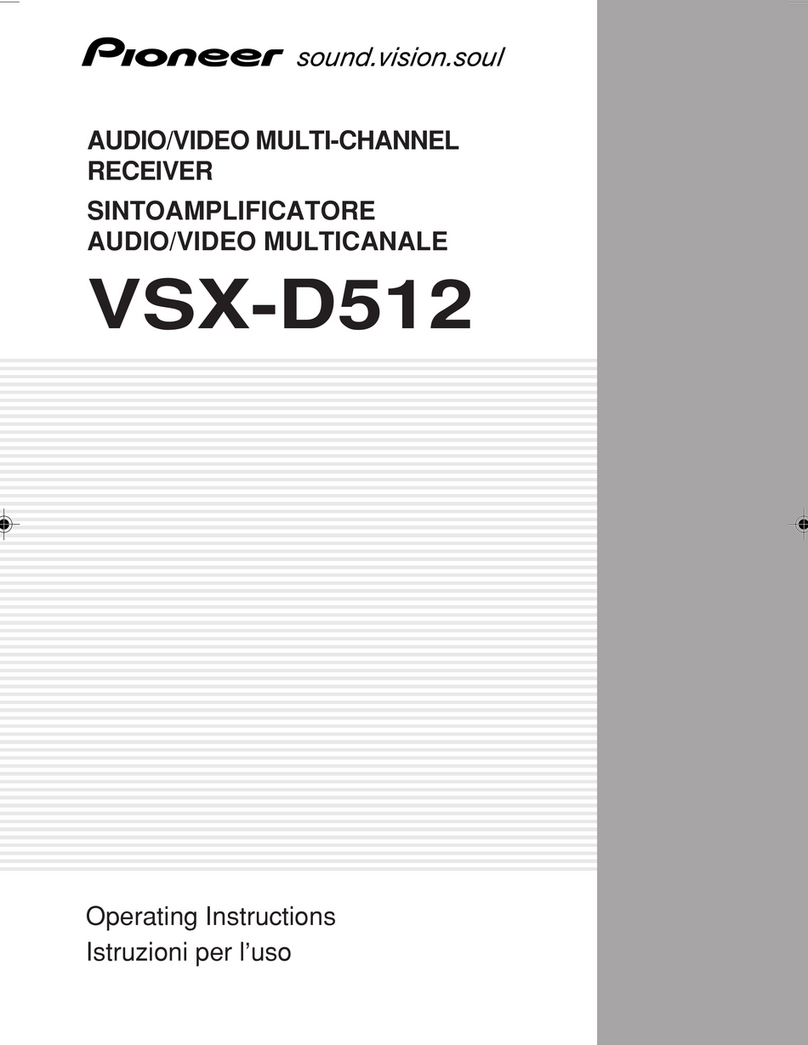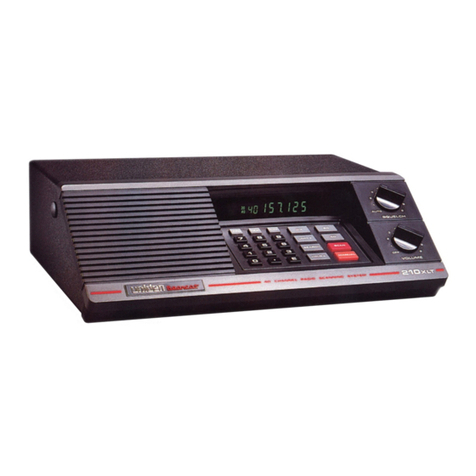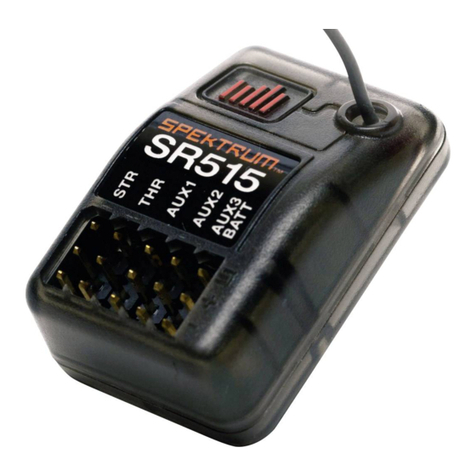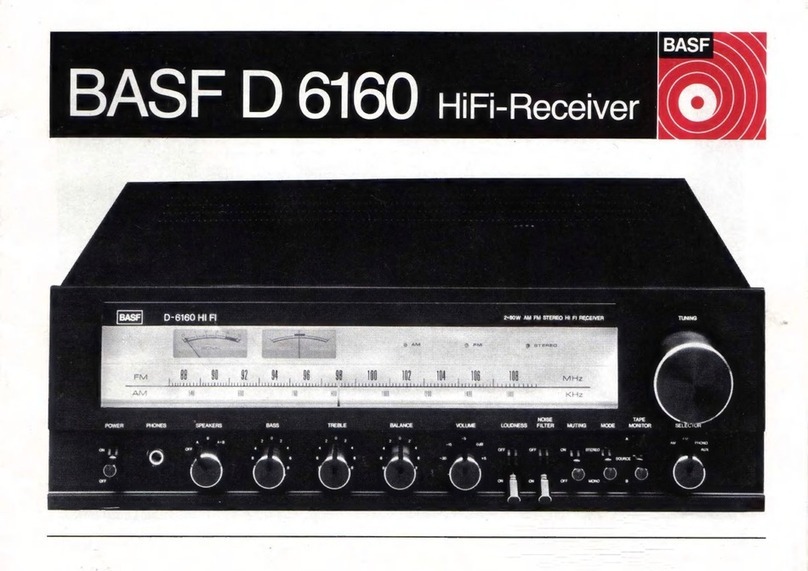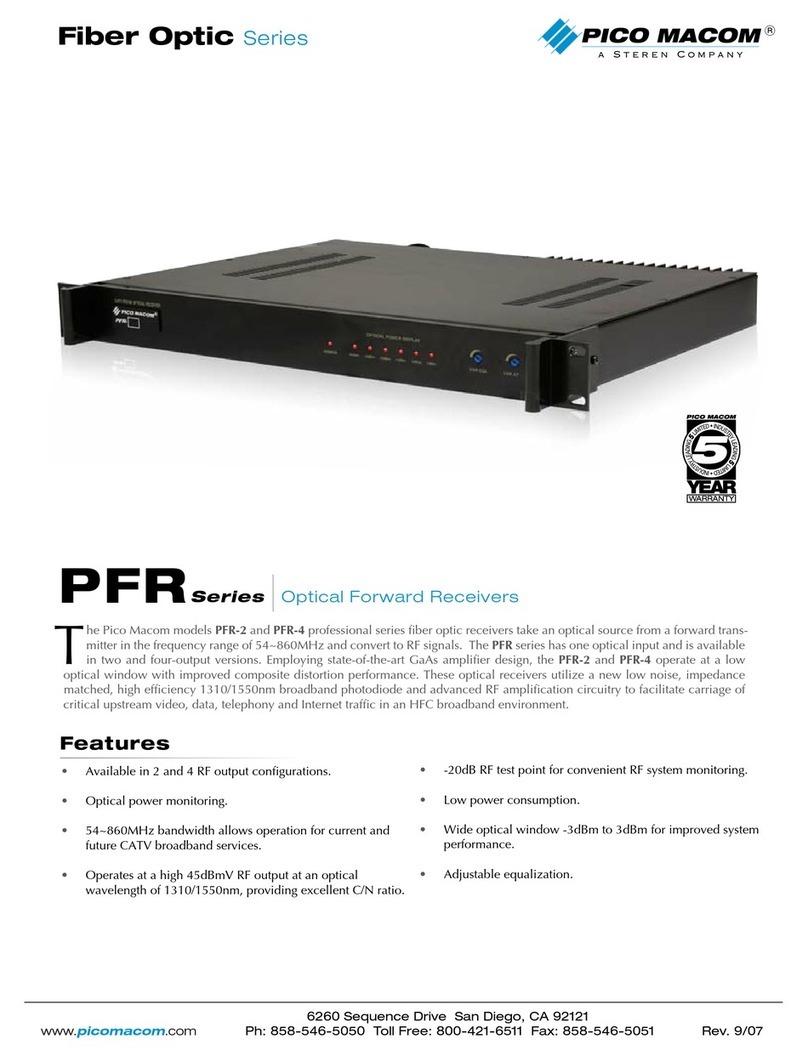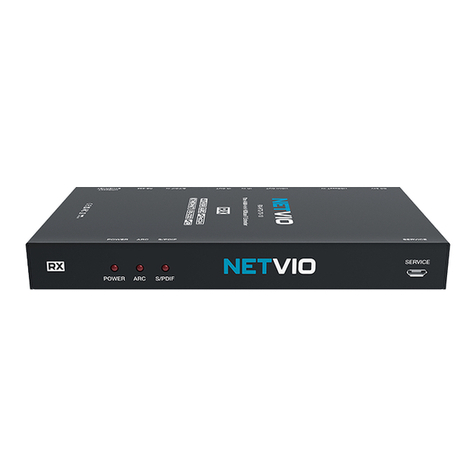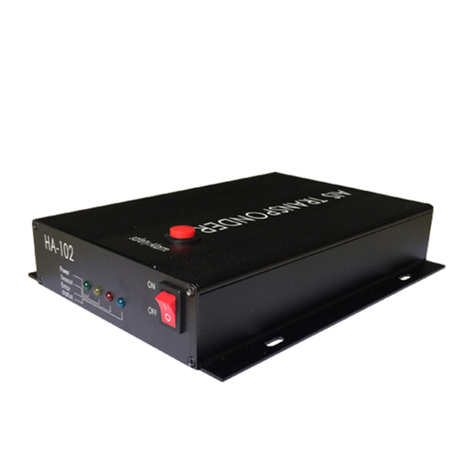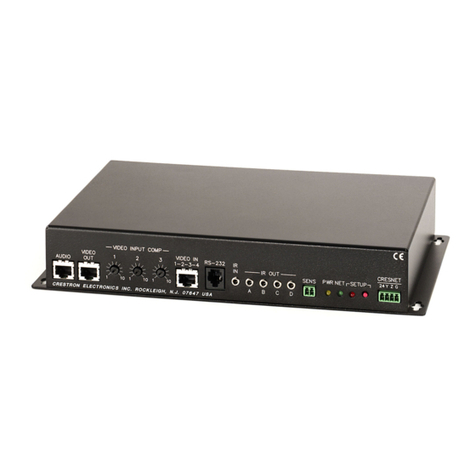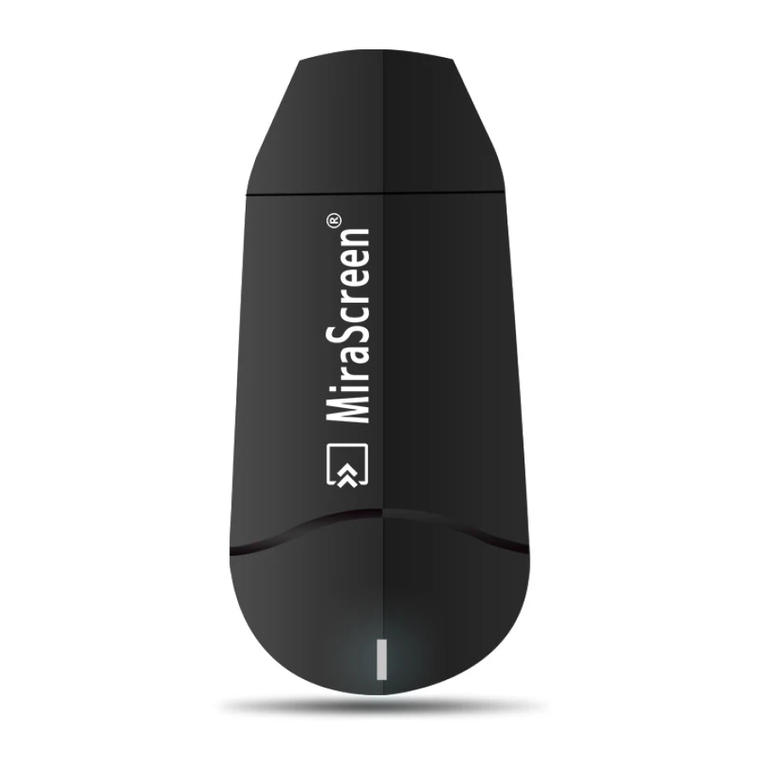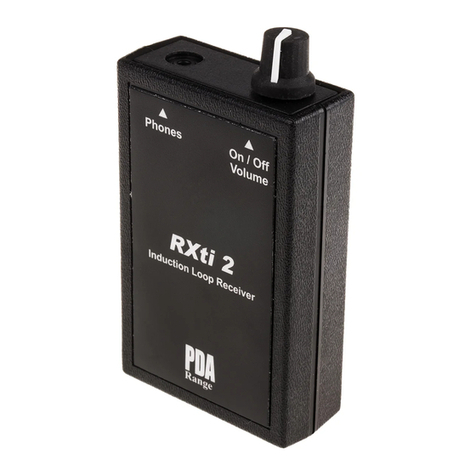Harman Consumer Group AVR75/85 User manual

AVR75/85
Dolby Digital Audio/Video Receiver
Harman Consumer Group
250 Crossways Park Drive
Woodbury, N.Y. 11797
1-800 422-8026 in the USA
A Harman International Company
Rev A 12/99
TECHNICAL MANUAL

2
Harman Kardon
Dolby Digital Audio/Video Receiver
AVR75/85
TABLE OF CONTENTS
ELECTROSTATICALLY SENSITIVE (ES) DEVISES ....4
LEAKAGE TEST ............................................................4
AVR75 & AVR85 FRONT PANEL CONTROLS.............5
AVR75 & AVR85 FRONT PANEL DISPLAY
INFORMATION ..........................................................7
AVR75 & AVR85 REMOTE CONTROL INFO ...............9
AVR75 & AVR85 REAR PANEL CONNECTIONS .......12
Service Bulletin #9705 for AVR85 .................................14
SERVICE AND ADJUSTMENT .....................................16
ALIGNMENT AND TEST POINTS.................................20
AVR75/85 BLOCK DIAGRAM........................................22
SPECIFICATIONS..........................................................23
AVR75 MECHANICAL EXPLODED VIEW
(120V AND 230V).....................................................32
AVR75 MECHANICAL PARTS LIST (120V & 230V) ...33
AVR85 MECHANICAL EXPLODED VIEW
(120V AND 230V).....................................................35
AVR85 MECHANICAL PARTS LIST (120V & 230V) ...36
AVR75/85 ELECTRICAL PARTS LISTS .......................38
GENERAL MISCELLANEOUS .................................38
PCB - PB04, Standby...............................................38
PCB - PC04, AC-3 Crossover..................................38
PCB - PW04, Headphone ........................................39
PCB PU04, Front......................................................39
PCB - PL94, Aux In..................................................40
PCB -PU54, Master Volume ....................................40
PCB - P724 ............................................................40
PCB - P734 ............................................................41
PCB - P744 ...........................................................41
PCB - P714, Voltage Amp .......................................41
PCB - PP04, Surround Amp ....................................42
PCB - PN54, Speaker Protect..................................42
PCB - P604 AC-3/DAC ............................................43
PCB - PU94, Power Switch......................................44
PCB - P704, Main.....................................................44
PCB - PS04, Audio Funtion .....................................46
PCB - P754, Speaker Terminal................................46
PCB - PS54, Audio Video ........................................46
PCB - PY04, Connect ..............................................47
PCB - PF04, Tone Control .......................................48
PCB - P104, Tuner...................................................48
PCB - P104 Tuner (230v) Discrepency List ............49
PCB - PE04, Electronic Volume Control..................50
PCB - PL54, S-Video ...............................................51
PCB - PL04, Video Selector.....................................51
AVR78 & AVR85 PACKING EXPLODED VIEW...........52
VOLTAGE AMP PCB - P714.........................................53
AC3/DAC PCB - P604 ...................................................54
MAIN PCB -P704 ...........................................................55
AUDIO FUNCTION PCB - PS04,
AUDIO/VIDEO PCB - PS54,
ELECTRONIC VOLUME CONTROL PCB - PE04,
AC-3 CROSSOVER PCB - PC04..................................56
SPEAKER TERMINAL PCB - P754,
VIDEO SELECTOR PCB - PL04,
CONNECT PCB - PY04.................................................57
S-VIDEO PCB - PL54, 120V
TUNER PCB - P104, 120V
STANDBY PCB - PB04, 120V
SURROUND AMP PCB - PP04, 120V..........................58
S-VIDEO PCB - PL54, 230V
TUNER PCB - P104, 230V
STANDBY PCB - PB04, 230
SURROUND AMP PCB - PP04, 230V..........................59
FRONT PCB - PU04,
S-VIDEO PCB - PL54, AVR85 ONLY
MASTER VOLUME PCB - PU54,
SPEAKER PROTECT PCB - PN54,
TONE CONTROL PCB - PF04,
AUX IN PCB - PL94,
POWER SWITCH PCB - PU94,
HEADPHONE PCB - PW04...........................................60
INTEGRATED CIRCUIT DIAGRAMS ........................61-71
AVR75/85 WIRING DIAGRAM (120V & 230V).............72
AVR75 (120V) SCHEMATIC DIAGRAM 1 of 8
(FRONT PCB PU04,
MASTER VOLUME PCB PU54,
AUX IN PL94) ................................................................73
AVR75 (120V) SCHEMATIC DIAGRAM 2 of 8
(TUNER PCB P104) ......................................................74
AVR75 (120V) SCHEMATIC DIAGRAM 3 of 8
(AUDIO SELECTOR PCB PS04,
AUDIO/VIDEO PCB PS54) ............................................75
AVR75 (120V) SCHEMATIC DIAGRAM 4 of 8
(AC-3 CROSSOVER PCB PC04,
TONE CONTROL PCB PF04,
VIDEO SELECTOR PCB PL04,
S-VIDEO PCB PL54) .....................................................76
AVR75 (120V) SCHEMATIC DIAGRAM 5 of 8
(CONNECT PCB PY04).................................................77

3
Harman Kardon
Dolby Digital Audio/Video Receiver
AVR75/85
AVR75 (120V) SCHEMATIC DIAGRAM 6 of 8
(VOLTAGE AMP PCB - P714,
MAIN PCB - P704,
SURROUND AMP PCB - PP04,
SPEAKER TERMINAL PCB - P754,
HEADPHONE PCB - PW04,
SPEAKER PROTECT PCB - PN54,
STANDBY PCB - PB04,
POWER SWITCH PCB - PU94)....................................78
AVR75 (120V) SCHEMATIC DIAGRAM 7 of 8
(ELECTRONIC VOLUME PCB - PE04) ........................79
AVR75 (120V/230V) SCHEMATIC DIAGRAM 8 of 8
(AC-3/DSP PCB - P604)................................................80
AVR75 (230V) SCHEMATIC DIAGRAM 1 of 7
(FRONT PCB - PU04,
MASTER VOLUME PCB - PU54,
AUX IN - PL94) .............................................................81
AVR75 (230V) SCHEMATIC DIAGRAM 2 of 7
(TUNER PCB - P104) ....................................................82
AVR75 (230V) SCHEMATIC DIAGRAM 3 of 7
(AUDIO SELECTOR PCB - PS04,
AUDIO/VIDEO PCB - PS54)..........................................83
AVR75 (230V) SCHEMATIC DIAGRAM 4 of 7
(AC-3 CROSSOVER PCB - PC04,
TONE CONTROL PCB - PF04,
VIDEO SELECTOR PCB - PL04,
S-VIDEO PCB - PL54)...................................................84
AVR75 (230V) SCHEMATIC DIAGRAM 5 of 7
(CONNECT PCB PY04).................................................85
AVR75 (230V) SCHEMATIC DIAGRAM 6 of 7
(VOLTAGE AMP PCB - P714,
MAIN PCB - P704,
SURROUND AMP PCB - PP04,
SPEAKER TERMINAL - P754,
HEADPHONE PCB - PW04,
SPEAKER PROTECT PCB - PN54,
STANDBY PCB - PB04,
POWER SWITCH PCB - PU94) ...................................86
AVR75 (230V) SCHEMATIC DIAGRAM 7 of 7
ELECTRONIC VOLUME CONTROL PCB, PE04........87
AVR85 (120V) SCHEMATIC DIAGRAM 1 of 8
(FRONT PCB - PU04,
MASTER VOLUME PCB - PU54,
AUX IN - PL94) ..............................................................88
AVR85 (120V) SCHEMATIC DIAGRAM 2 of 8
(TUNER PCB - P104) ....................................................89
AVR85 (120V) SCHEMATIC DIAGRAM 3 of 8
(AUDIO SELECTOR PCB - PS04,
AUDIO/VIDEO PCB - PS54)..........................................90
AVR85 (120V) SCHEMATIC DIAGRAM 4 of 8
(AC-3 CROSSOVER PCB - PC04,
TONE CONTROL PCB - PF04,
VIDEO SELECTOR PCB - PL04,
S-VIDEO PCB - PL54)...................................................91
AVR85 (120V) SCHEMATIC DIAGRAM 5 of 8
(CONNECT PCB - PY04) ..............................................92
AVR85 (120V) SCHEMATIC DIAGRAM 6 of 8 (VOLTAGE
AMP PCB - P714, MAIN PCB - P704, SURROUND AMP
PCB - PP04, SPEAKER TERMINAL - P754,
HEADPHONE PCB - PW04, SPEAKER PROTECT PCB
- PN54, STANDBY PCB - PB04, POWER SWITCH PCB
- PU94) ..........................................................................93
AVR85 (120V) SCHEMATIC DIAGRAM 7 of 8
(ELECTRONIC VOLUME PCB - PE04) ........................94
AVR85 (120V & 230v) SCHEMATIC DIAGRAM 8 of 8
(AVR85 DSP BOARD - P604).......................................95
AVR85 (230V) SCHEMATIC DIAGRAM 1 of 8 (FRONT
PCB - PU04, MASTER VOLUME PCB - PU54, AUX IN -
PL94) ..............................................................................96
AVR85 (230V) SCHEMATIC DIAGRAM 2 of 8
(TUNER PCB - P104) ....................................................97
AVR85 (230V) SCHEMATIC DIAGRAM 3 of 8
(AUDIO SELECTOR PCB - PS04,
AUDIO/VIDEO PCB PS54) ............................................98
AVR85 (230V) SCHEMATIC DIAGRAM 4 of 8
(AC-3 CROSSOVER PCB - PC04,
TONE CONTROL PCB - PF04,
VIDEO SELECTOR PCB - PL04,
S-VIDEO PCB PL54) .....................................................99
AVR85 (230V) SCHEMATIC DIAGRAM 5 of 8
(CONNECT PCB PY04)................................................100
AVR85 (230V) SCHEMATIC DIAGRAM 6 of 8
(VOLTAGE AMP PCB - P714,
MAIN PCB - P704,
SURROUND AMP PCB - PP04,
SPEAKER TERMINAL - P754,
HEADPHONE PCB - PW04,
SPEAKER PROTECT PCB - PN54,
STANDBY PCB - PB04,
POWER SWITCH PCB - PU94)...................................101
AVR85 (230V) SCHEMATIC DIAGRAM 7 of 8
(ELECTRONIC VOLUME PCB PE04) ........................102

4
Harman Kardon
Dolby Digital Audio/Video Receiver
AVR75/85
ELECTROSTATICALLY SENSITIVE (ES) DEVICES
Some semiconductor (solid state) devices can be damaged easily by
static electricity. Such components commonly are called Electrostatically
Sensitive (ES) Devices. Examples of typical ES devices are integrated
circuits and some field effect transistors and semiconductor “chip”
components. The following techniques should be used to help reduce
the incidence of component damage caused by static electricity.
1. Immediately before handing and semiconductor component or
semiconductor-equipped assembly, drain off any electrostatic charge on
your body by touching a known earth ground. Alternatively, obtain and
wear a commercially available discharging wrist strap device, which
should be removed for potential shock reasons prior to applying power to
the unit under test.
2. After removing an electrical assembly equipped with ES devices, place
the assembly on a conductive surface such as aluminum foil, to prevent
electrostatic charge buildup or exposure of the assembly.
3. Use only a grounded-tip soldering iron to solder or unsolder ES
devices.
4. Use only a anti-static solder removal device. Some solder removal
devices not classified as “anti-static” can generate electrical charges
sufficient to damage ES devices.
5. Do not use freon-propelled chemicals. These can generate electrical
change sufficient to damage ES devices.
6. Do not remove a replacement ES device from its protective package
until immediately before you are ready to install it. (Most replacement ES
devices are packaged with leads electrically shorted together by
conductive foam, aluminum foil or comparable conductive material.)
7. Immediately before removing the protective material from the leads of
a replacement ES device, touch the protective material to the chassis or
circuit assembly into which the device will be installed.
CAUTION: Be sure no power is applied to the chassis or circuit, and
observe all other safety precautions.
8. Minimize bodily motions when handling unpackaged replacement ES
devices. (Otherwise harmless motion such as the brushing together or
your clothes fabric or the lifting of your foot from a carpeted floor can
generate static electricity sufficient to damage an ES device.)
LEAKAGE TEST (FOR SERVICE ENGINEERS IN THE U.S.A.)
Before returning the unit to the user, preform the following safety checks:
1. Inspect all lead dress to make certain that leads are not pinched or that hardware is not lodged between parts in the unit.
2. Be sure that any protective devices such as nonmetallic control knobs, insulating fishpapers, cabinet backs, adjustment and compartment covers or
shields, isolation resistor-capacity networks, mechanical insulators, etc. which were removed for servicing are properly reinstalled.
3. Be sure that no shock hazard exists; check for leakage
current using Simpson Model 229 Leakage Tester, standard
equipment item No. 21641, RCA Model WT540A or use
alternate method as follows: Plug the power cord directly into
a 120-volt AC receptacle (do not use an Isolation
Transformer for this test). Using two clip leads, connect a
1500 Ohm, 10-watt resistor parallel by a 0.15mF capacitor, in
series with all exposed metal cabinet parts and a known
earth ground, such as a water pipe or conduit. Use a VTVM
or VOM with 1000 Ohms per volt, or higher sensitivity to
measure the AC voltage drop across the resister. (See
Diagram.) Move the resistor connection to each exposed
metal part having a return path to the chassis (antenna,
metal, cabinet, screw heads, knobs and control shafts,
escutcheon, etc.) and measure the AC voltage drop across
the resistor. (This test should be performed with the power
switch in both the On and Off positions.)
A reading of 0.35 volt RMS or more is excessive and
indicates a potential shock hazard which must be corrected
before returning the unit to the owner.

5
Harman Kardon
Dolby Digital Audio/Video Receiver
AVR75/85
AVR75 & AVR85 FRONT PANEL CONTROLS
1. Power: Press this button once to turn the unit on and off.
Once the unit is turned on, it may be turned off and then on
again from the remote, if desired.
NOTE: When the remote is used to turn the unit off the LED
surrounding the Power Switch will turn amber, indicating
that the AVR75/85 is in a Standby mode. In this condition
the unit is NOT disconnected from the AC main power
supply.
2. AM/FM Tuner Selector: Press this button once to select
the tuner. Press it again to switch between AM and FM.
3. Headphone Jack: Plug standard stereo headphones into
this jack for private listening.
NOTE: When the headphones are in use the output to the
speakers is muted and the surround mode is automatically
switched to STEREO. When the headphones are removed
from the jack, sound to the speakers is restored and the unit
returns to the previous sound mode.
TV DVD V1 V2 V3
VISUAL
kHz
MHz
dB
AC-3 PCM
DIGITAL PRO LOGIC 3 STEREO
HALL
STEREO
MOVIE RF OPT
MATRIX
TEST
COAX NIGHT LFE ATT
SLEEP P-SCAN DISP
MEMO
AUTO
TUNED
STEREO
TV DVD V1 V2 V3
VISUAL
kHz
MHz
dB
AC-3 PCM
DIGITAL PRO LOGIC 3 STEREO
HALL
STEREO
MOVIE RF OPT
MATRIX
TEST
COAX NIGHTMULTI LFE ATT
SLEEP P-SCAN DISP
MEMO
AUTO
TUNED
STEREO
DOLBY
DIGITAL
DOLBY
DIGITAL
AM/FM
AM/FM
CD
CD
T-1/MON
T-1/MON
T-2
T-2
TV
TV
DVD
DVD
V1
V1
V2
V2
V3 MULTI
V3
OSD
OSD
ATT
ATT
MEMO
MEMO
CLR
CLR
MODE
MODE
P-SET
P-SET
P-SCN
P-SCN
TUNE
TUNE
MUTE
MUTE
VIDEO 3
VIDEO 3
Volume
Volume
Video
Video
L - Audio - R
L - Audio - R
Balance
Balance
Treble
Treble
Bass
Bass
Mode
Mode
Coax
Coax
OPT
OPT
RF
RF
Night
Night
Phones
Phones
Power
Power
L
L
Min
Min
Min
Min
R
R
Max
Max
Max
Max
Digital Input
Digital Input
AVR 85
AVR 75
harman/kardon
harman/kardon
28 27 26
135791113
15 17 19 21 23
2 4 6 8 10 12 14 16 18 20 22
24 25
28 27 26
135791113
15 17 19 21 23
2 4 6 8 10 12 14 16 18 20 22
24 25
2929

6
Harman Kardon
Dolby Digital Audio/Video Receiver
AVR75/85
4. CD: Press this button to select the CD player.
5. Tape 1/Monitor: Press this button to select Tape One as
the input source. A red LED above the button will illuminate
to indicate that the Tape Monitor has been selected.
6. Night Mode: Press this button to activate the “Night”
mode, preventing loud playback when the digital modes are
in use.
7. Tape 2: Press this button to select tape 2 input.
8. TV Input: Press this button to select the source
connected to the TV Input (38).
9. Digital input Selectors: Press one of these buttons to
select a digital input source. The digital audio source may
be the same as, or different from, the analog audio of the
selected video source.
10. DVD Input: Press this button to select the source
connected to the DVD Input (37). Note that the DVD or LV
player’s digital audio output is used, it must be selected
separately using the Digital Input Selectors (9).
11. Video Sources: Press any of these buttons to select a
video input source.
12. Mode: Press these buttons to scroll up or down through
the list of available surround modes.
13. OSD (On-Screen Display): Press this button to activate
the Attenuation mode which cuts the analog input signal by
50% to compensate for high-level input sources.
14. ATT Attenuation Mode Select: Press this button to
activate the Attenuation Mode which cuts the analog input
signal by 50% to compensate for high-level input sources.
15. Memo: The memo button is used to enter stations to the
tuner’s preset memory in either the manual or automatic
modes.
16. Clear: The clear button is used to cancel tuning,
memory input or when cleaning the unit’s memories.
17. FM Mode: Press this button to select the tuning mode
for FM stations.
18. Bass: This knob adjusts the tone of low-frequency
sounds. Turn it to the right to boost bass frequencies or to
the left to cut bass frequencies.
19. Treble: This knob adjusts the tone of high-frequency
sounds. Turn it to the right to boost high frequencies or to
the left to cut high frequencies.
20. P-Set: Press this button to manually scroll up or down
through the FM or AM stations programmed into the
receiver’s preset memory.
21. Balance: This knob adjusts the balance between the
front left and right speakers.
22. P-Scan: Press this button to automatically scan through
the FM or AM stations preset into the receiver’s memory.
Press the button again to stop the scan when the tuner is at
the desired station.
23. Tune: Press this button to manually scan up or down
through the FM or AM bands.
24. Video 3 Input: Audio or Video sources connected to
these jacks may be selected by pressing the Video Source
button (11).
25. Mute: Press this button to cut the output to the
speakers. Press it again to return to the previous volume
level.
26. Volume Control: Turn the knob clockwise to increase
volume, counterclockwise to decrease the volume. Note
that approximately two revolutions of the knob are required
to go from no output to maximum volume.
27. Information Display: This display delivers messages
and status indications to help you operate the receiver.
Refer to the separate diagram for complete explanation of
the FL display.
28. Remote Sensor Window: The sensor behind this
window receives infrared signals from the remote control.
Aim the remote at this area and do not block or cover it
unless an external remote sensor is installed.
29. Multiroom Control: NOTE: this feature differentiates
the AVR85 from the AVR75. The AVR75 does not have
this feature. Press this button to turn the remote room feed
On or Off. The MULTI indicator (D) will light or flash when
the remote feed is On. Note that the remote feed will remain
On after the main room power is turned Off until it is
switched Off by pressing this button again.

7
Harman Kardon
Dolby Digital Audio/Video Receiver
AVR75/85
AVR75 & AVR85 FRONT PANEL DISPLAY
TV
TV
DVD
DVD
V1
V1
V2
V2
V3
V3
VISUAL
VISUAL
kHz
MHz
kHz
MHz
dB
dB
AC-3
AC-3
PCM
PCM
DIGITAL
DIGITAL
PRO LOGIC
PRO LOGIC
3 STEREO
3 STEREO
HALL
HALL
STEREO
STEREO
MOVIE
MOVIE
RF
RF
OPT
OPT
MATRIX
MATRIX
TEST
TEST
COAX
COAX
NIGHT
NIGHT
MULTI LFE
LFE
ATT
ATT
SLEEP
SLEEP
P-SCAN
P-SCAN
DISP
DISP
MEMO
MEMO
AUTO
AUTO
TUNED
TUNED
STEREO
STEREO
Q
Q
P
P
O
O
N
N
M
M
L
L
R
R
S
S
A
A
B
B
C
C
E
E
DF
F
G
G
H
H
I
I
K
K
J
J
AVR85 DISPLAY
AVR75 DISPLAY
A. AC-3 Indicator: This indicator illuminates when the
AVR75 is decoding a Dolby Digital input source.
B. Surround Mode Status: These indicators display the
currently selected surround mode.
C. Digital Mode Indicators: These indicators show which
digital input is in use.
D. Multi: This indicator signifies that the AVR85 is sending
a program source to a remote room location. Note that it
may be illuminated even when the unit is “off” in the main
listening room, signifying that operation continues at
another location. When a remote command is being
received via the Multi IR connection (59), this indicator will
flash. NOTE: this feature differentiates the AVR85 from
the AVR75. The AVR75 does not have this feature.
E. Sleep Indicator: This indicator lights when the
AVR75/85 is in the Sleep mode.
F. Night Indicator: This indicator lights when the
AVR75/85 is in Night mode, which prevents the AVR75/85
from loud playback when digital sources are in use.

8
Harman Kardon
Dolby Digital Audio/Video Receiver
AVR75/85
G. P-Scan: This indicator flashes when the stations
programmed into the tuner memory are being automatically
reviewed.
H. LFE Indicator: This indicator will illuminate when the
Low-Frequency Effects (LFE) option has been turned on
through the controls in SETUP MENU 3.
I. DISP: This indicator lights when the FL display has been
turned off using the Display button (16) to remind you that
the unit is still turned on.
J. ATT Indicator: This indicator lights when the Attenuation
function has been engaged to cut the input from analog
sources by approximately 50%.
K. Main Information Display: This ten-digit display shows
messages relating to the status, input source, surround
mode, tuner, volume level or other aspects of unit’s
operation.
L. Stereo: This indicator lights when an FM station is
broadcasting in stereo.
M. Tuned: This indicator lights when an AM or FM station is
properly tuned and locked.
N. Auto: This indicator signifies that the Automatic Tuning
mode is in use for FM broadcasts.
O. Memo: This indicator flashes when the Memo button is
pressed when entering presets and other information into
the tuner’s memory.
P. Test: This indicator flashes when the output levels are
being set using the built-in test signal generator.
Q. “Visual” Indicator: These indicators display which input
source is being fed to the video monitor output.
R. PCM Indicator: This indicator illuminates to show that a
standard PCM (S/P-DIF) digital audio signal is being
decoded by the digital-to-analog converter.
S. Signal Level Indication: This is a visual indication of the
the strength of a radio station signal. The more bars visible,
the stronger the station.

9
Harman Kardon
Dolby Digital Audio/Video Receiver
AVR75/85
AVR75 & AVR85 REMOTE CONTROL
Use/Learn
Source Power
Main Power
Source Selection
Night Mode
Delay
DigitalAudio Input Selectors
Multiroom Control
Menu Controls
Select
OSD
Test Tone
Channel Select
Speaker Level Adjust
Main Volume
Display
Mute
Transport Controls
Tune/Search and Fast Forward
Preset/Disc
Channel/Skip
Memo
P-Scan
Number Keys
Surround Mode Selection
Sleep
Learn LED
Sending LED
**
PRESET PRESET
DISC DISC
ON ONOFF OFF
DISPLAY DISPLAY
/ /
MUTE MUTE
Source Power Source Power
DVD DVD
TV TV
VID 1 VID 1
VID 2 VID 2
TAPE 2 TAPE 2
SELECT SELECT
TAPE 1 TAPE 1
CD CD
AM/FM AM/FM
VID 3 VID 3
# #
SKIP SKIP
TUNE/ TUNE/
SEARCH SEARCH
VOLUME VOLUME
++
__
SLEEP SLEEP
MOVIE MOVIEAC-3 AC-3
NIGHT NIGHT
1 12 23 3
STEREO STEREOMATRIX MATRIXHALL HALL
DELAY DELAY
4 4
5 5
6 6
RF RF
7 78 89 9
TEST TONE TEST TONE
SPEAKER SPEAKER
CH SELECT CH SELECT
COAX COAX
MULTI
OPT OPT
0 0
OSD OSD
AVR 75 AVR 85
Sending Sending
Use Use
Learning Learning
Learn Learn
P/L P/L3ST 3ST
ON ONOFF OFF
Main Power Main Power
PTY PTY
DEF DEFGHI GHI
JKL JKL
MNO MNOPQR PQR
STU STUVWX VWXYZ YZ
ABC ABC
AF AF
FM MODE FM MODE
RDS DISP. RDS DISP.
TUNE/ TUNE/
SEARCH SEARCH
OSD OSD
MEMO MEMO
CLEAR CLEARP-SCAN P-SCAN
8
66
10 10
12 12
44
22
77
99
11 11
13 13
55
33
11
1
2
3
4
5
6
7
8
9
10
11
12
13
14
15
16
17
18
19
20
21
22
23
24
25
26
27
28
28 2827 27
26 26
24 24
22 22
20 20
18 18
16 16
14 14
25 25
23 23
21 21
19 19
17 17
15 15

AVR75 & AVR85 REMOTE CONTROL INFORMATION ...continued
1. Use/Learn: This switch selects the operation mode of the
remote control. Slide it to the left for normal operation. Slide
it to the right when the remote is being programmed.
2. Source Power: When power on/off commands have
been programmed into the remote’s memory, press these
buttons to control power for the last source device selected.
3. Main Power: Press these buttons to turn the unit on or
off (to Standby Mode).
4. Source Selection: Pressing one of these buttons selects
the input source that will be listened to through the receiver.
When a source is selected the remote’s transport and
numeric number buttons will also transmit the commands
needed to control that machine.
5. Night Mode: Press this button to activate the “Night”
mode, preventing loud playback when the digital modes are
in use without altering the dynamic range of the output
signal.
6. Delay: Press this button to change the delay for the
surround channels when the Surround Mode Menu is on the
screen.
7. Digital Audio Input Selectors: Press one of these
buttons to select a digital input source. The digital audio
source may be the same as, or different analog audio of the
selected video source.
8. Multiroom Control: Press this button to turn the remote
room feed on or off. The Multi indicator will light or flash
when the remote feed is on. Note that the remote zone feed
will remain on after the main room power is turned off until it
is switched off by pressing this button again.
9. Menu Controls: These buttons control the action of the
cursor or the selection of menu items when the receiver is
being configured using the setup menus.
10. Select: This button enters settings to the receiver’s
memory during system configuration.
11. OSD: Press this button to activate the on-screen menu
system.
12. Test Tone: Press this button to begin calibration of the
output level for each channel. A test signal will immediately
be heard from the left front speaker and the Test indicator
will flash.
13. Channel Select: Press this button to view a status
report of the output level for each channel. When the Test
Tone is audible and the system output levels are being set,
pressing this button will advance the channel being adjusted
in a clockwise direction to the next channel.
14. Speaker Level Adjust: When setting the system output
levels, press these buttons to increase or decrease the
output level.
15. Main Volume: These buttons control the unit’s volume.
Note that all channels are controlled simultaneously.
16. Display: Press this button to turn off all displays and
indicators in the Information Display except for a small Disp
indication in the lower right corner of the display . Press
the button again to turn the display back on.
17. Mute: Press this button to temporarily cut the audio
output of the receiver. Press it again to return to the
previous volume level.
18. Transport Controls: These buttons may be
programmed to control the tape or disc motion of the last
playback source selected with the Source Selection
buttons . Use them as you would the Play, Stop, Pause,
Record, Reverse Play and Forward Play buttons on any
VCR,CD, cassette, DVD or LD remote control. The
Reverse Play button also operates the FM Mode
function of the AVR75/85’s tuner.
NOTE: The , and buttons are also used
to control the PTY, AF and RDS Display functions of the
tuner.
19. Tune/Search & Fast Forward: These buttons may be
programmed to have multiple functions, which vary
according to the input device selected.
a. When the TUNER has been selected, these buttons
are used to tune stations.
b. When CD,Tape,DVD,LD or VCR is the input source,
these buttons act as the Fast Scan Forward or
Fast Scan Reverse controls.
10
Harman Kardon
Dolby Digital Audio/Video Receiver
AVR75/85
D
P
I
4

20. Preset/Disc: These buttons have multiple functions,
which may vary according to the input device codes
programmed.
a. When the TUNER has been selected, these buttons
will scroll up or down through the stations
that have been programmed in the preset memory.
b. When CD is selected and the unit is a CD changer,
these buttons will change to the next disc or
previous disc .
c. When Tape 1 or Tape 2 is the input source, and the
tape machine is a compatible Harman Kardon dual
cassette deck, these buttons will switch between the
“A” and “B” sides.
21. Channel/Skip: These buttons have multiple functions,
which vary according to the input device selected and the
codes programmed from another remote.
a. When TV, Vid 1 or Vid 2 are selected, they may
function as the channel up or channel down
tuning buttons when programmed with the codes from
another unit’s remote.
b. When CD is selected these buttons act as forward and
reverse “Skip” buttons to move to the next track or
chapter on the disc.
c. When a compatible Harman Kardon cassette player
has been selected as Tape 1 or Tape 2, these
buttons move the tape forward or backwards
to the next selection using the Music Scan feature.
22. Memo: The memo button is used to enter stations to
the tuner’s preset memory in either the manual or automatic
modes. It is also used in the process of clearing the
memory. This button also performs the functions of the “ ”
symbol on compatible equipment.
23. P-Scan: Press this button to automatically scan through
the stations preset into the tuner memory. Press the button
again to end the scan when the tuner stops at the desired
station. This button also performs the functions of the “ ”
symbol on compatible equipment.
24. Number Keys: These buttons serve as a ten button
numeric keypad to enter tuner preset positions. They are
also to be used to select channel numbers when TV has
been selected on the remote, or to select track numbers on
aCD,DVD or LD player, depending on how the remote has
been programmed. The letters below the buttons are used
to enter information for tuner station names.
NOTE: The 0button has a dual function. It also serves
as the CLEAR button for use in programming the tuner
or clearing the system memory.
25. Surround Mode Selection: Press one of these buttons
to select a surround mode for the current listening session.
26. Sleep (AVR75): Press this button when the Sleep timer
has previously been activated to view the time remaining
before the unit turns off to the Standby Mode. To activate
the Sleep function, first put the unit in the Tuner Mode by
pressing the AM/FM button . Next, press the Sleep
button and note that the Sleep and Memo indicators
will blink. Within that blinking time press the Memo
button and then press the Sleep button again to set
the sleep time in the following order:
When the desired time is shown in the display, press the
Memo button to enter the time. The unit will go into
the Standby Mode when the time entered has elapsed.
26. Sleep (AVR85): Pressing this button when the Sleep
timer has previously been activated allows you to view the
time remaining before the timer function turns the unit off.
When the remote is in the AM/FM mode ,the Sleep
function may also be changed or set by pressing this button
so that the Sleep and Memo indicators blink (timer not
yet set) or Sleep time is indicated (timer set already). Within
that time press the Memo button so that both
indicators blink slowly. Now press the Sleep button
again to set the desired sleep time in the following order:
When the desired time is shown in the display, press the
Memo button to enter the time. The unit will go into
the Standby Mode when the time entered has elapsed.
27. Learn LED: This indicator will illuminate when a button
on the remote is being programmed with signals from
another remote during the “learning” mode. The light will go
out when the signal is received and memorized.
28. Sending LED: This indicator should flash any time a
button is pressed to confirm that a command is being sent to
the receiver or another unit. If the light is dim or does not
illuminate when a button is pressed the batteries in the
remote should be replaced.
11
Harman Kardon
Dolby Digital Audio/Video Receiver
AVR75/85
10
min 20
min 30
min 40
min 50
min 60
min 90
min OFF
15
15
22
22
4
2
E
O
4
EO
22
15
10
min 20
min 30
min 60
min 90
min OFF
22
15
26
26

12
Harman Kardon
Dolby Digital Audio/Video Receiver
AVR75/85
AVR75 & AVR85 REAR PANEL CONNECTIONS
30. AM Antenna: Connect the AM loop antenna supplied
with the receiver to these terminals. If an external AM
antenna is used, make connections to the AM and GND
terminals in accordance with the instructions supplied with
the antenna.
31. FM Antenna: Connect an indoor or external FM
antenna to this terminal.
32. Tape 2 Out: Connect these jacks to the
RECORD/INPUT jacks of a second audio recorder.
33. Tape 2 In: Connect these jacks to the PLAY/OUT jacks
of a second audio recorder.
34. Tape 1 Out: Connect these jacks to the
RECORD/INPUT jacks of an audio recorder.
35. Tape 1 In: Connect these jacks to the PLAY/OUT jacks
of an audio recorder.
36. CD IN: Connect these jacks to the output of a compact
disk player or CD changer.

13
Harman Kardon
Dolby Digital Audio/Video Receiver
AVR75/85
37. DVD Inputs: Connect the analog audio outputs and
composite or S-Video output of a DVD or LV player to these
jacks.
38. TV Inputs: Connect these jacks to the audio and video
outputs of a TV Tuner, Cable TV converter box, satellite
receiver, or any other audio/video source.
39. Pre-Outs: If external power amplifiers are used for any
channels, connect them to these jacks.
40. Subwoofer Pre-Out: Connect this jack to the line level
input of a powered subwoofer. If an external subwoofer
amplifier is used, connect this jack to the subwoofer
amplifier input.
41. Center: Connect these terminals to the center speaker.
42. Surround: Connect these terminals to the surround
speakers.
43. Front: Connect these terminals to the front speakers.
44. Switched AC Outlet: This outlet may be used to power
any device that you any wish to have on when the unit is
turned on.
45. Unswitched AC Outlet: This outlet, may be used to
power any AC device. The power will remain on at this
outlet regardless of whether the AVR75/85 is on or off.
NOTE: The power consumption of the device plugged into
each of these outlets should not exceed 120 watts.
46. Power Cable: Connect the AC plug to a non-switched
AC wall output.
47. AC-3/PCM Optical Input: Connect the optical digital
output from a DVD player, HDTV receiver, LV player or CD
player to this jack. The signal may be either a Dolby Digital
(AC-3) signal or a standard PCM digital source.
48. AC-3/PCM Coaxial Input: Connect the coax digital
output from a DVD player, HDTV receiver, LV player or CD
player to this jack. The signal may be either a Dolby Digital
(AC-3) signal or a standard PCM digital source.
49. AC-3 RF Input: Connect the AC-3 RF output of an LV
player equipped for digital audio to this jack.
NOTE: Do not connect standard analog sources to these
jacks (48)(49).
50. Remote IR In: If the AVR75/85’s front panel IR sensor is
blocked due to cabinet doors or other obstructions, an
external IR sensor may be used. Connect the output of the
sensor to this jack.
51. Remote IR Out: This connection permits the IR sensor
in the receiver to serve other remote controlled devices.
Connect this jack to the “IR IN”jack on Harman Kardon or
other compatible equipment.
52. VCR 1 Inputs: Connect these jacks to the audio, video
and S-Video PLAY/OUT jacks of a VCR.
53. VCR 1 Outputs: Connect these jacks to the audio,
video and S-Video RECORD/IN jacks of a VCR.
54. TV Monitor S-Video Output: Connect this jack to the
S-Video input of the TV monitor or video projector to view
S-Video sources selected by the receiver’s video switcher.
NOTE: Standard (composite) video and S-Video signals will
appear only at their respective output. The AVR75/85 does
not convert one video format to anther.
55. TV Monitor Video Output: Connect this jack to the
standard (composite) video input of a TV monitor or video
projector to view the on-screen menus and the output of any
standard video source selected by the receiver’s video
switch.
56. VCR 2 Outputs: Connect these jacks to the audio,
video and S-Video RECORD/IN jacks of a second VCR.
57. VCR 2 Inputs: Connect these jacks to the audio, video
and S-Video PLAY/OUT jacks of a second VCR.
58. Multiroom Audio Outputs: Connect these jacks to the
optional audio power amplifier that powers remote room
speakers with the input selected by the multiroom control
system. This feature is found only on the AVR85.
59. Multi IR: Connect the output of an IR sensor in a remote
room to this jack to operate the AVR85’s multiroom control
system. This feature is found only on the AVR85.

Service Bulletin #9705 for AVR85
Service bulletin # 9705 August 1997
To: All harman/kardon Service Centers
Models: AVR85
Subject: No audio output
In the event you receive an AVR85 with the complaint “no audio output”(even though the display is
lit up normally), perform the necessary steps listed below:
PROCEDURE:
1) Make sure the receiver is OFF and unplugged; remove the top cover of the unit.
2) Position the unit on its side, facing it so you are looking at the bottom cover, with the front of the receiver
facing left. The power transformer should be down, or nearest the work bench.
3) Remove the front right “foot”of the unit; then with a sharp pair of dikes or wire cutters cut the (16) metal
connections on the bottom screen attaching it to the bottom cover. Remove bottom screen from unit; for
safety continue to cut all the remaining severed metal tabs from the bottom cover.
4) Locate and discharge main power supply electrolytic capacitors C802 & C803 with a 10 ohm, 10 watt resistor.
At this point, C802 & 803 are at the top of the main PCB; The two leads to C803 can be identified by the
marking “-B”on the PCB; C802 is just above it. After discharge, check with voltmeter that capacitors have
less than 1 volt DC across leads to confirm that discharge is complete.
5) See drawing; locate two areas of a poor solder connection due to an unintended mask, or dark-colored dot
that is partially covering the solder pad(s) where the leads come through. Unsolder the connection(s) with
solder wick. Clean & scrape, if necessary, with a small screwdriver the foil/pad area thoroughly and remove
any excess mask residue. Re-solder the connection(s) carefully to assure good connections.
6) Turn the unit upright; locate PCB P714, the small vertical circuit board nearest the main heatsink. Unplug
and remove small molex connector J701 at the top of the board; then remove the four mounting screws and
metal tabs holding the top of the board in place.
7) Remove the two locks to the two sockets, J714 and J716. Take care not to damage the lock or connector
while attempting to unlatch the PCB; then unplug and remove the entire PCB P714.
8) Locate 10 ohm, ¼watt resistors RH23, RH24, R745, R746, R747, R748; test with multimeter to assure they
are still 10 ohms +/- 5%. If values are different (indicating damage), replace as necessary.
9) Return PCB P714 to unit; re-attach molex connector; replace 4 screws and mounting tabs. Replace top cover
of receiver.
10) Re-attach the bottom screen to the bottom cover using 12 screws, (H/K# 51260306MO); the screen will be
upside-down compared to its former position when attached; replace the unit’s“foot”.
11) TO TEST:
a) Plug in the unit; connect speakers to left, right, and center output terminals.
b) Turn the unit on; switch the unit to “Prologic”mode by use of the mode buttons on the front panel.
c) Press the button “TEST TONE”on the remote control. The display should read “FRONT L”and “TEST”
should flash.
d) Adjust the master volume, and verify test noise is heard from front left channel.
e) Press the button “CH SELECT”on the remote control to change to the right and center speakers, and
verify test noise is heard from each one.
f) Press the button “TEST TONE”on the remote control again to exit the test.
Model Serial number
120V
Serial number
230V Status Action
AVR85 MJ0011-01001
to
MJ0011-02500
MJ0012-01001
to
MJ0012-01500
Poor connections in
two areas on main
PCB
Clean & re-solder connections, check
or replace RH23,RH24,R745.R746,
R747, R748 if necessary
AVR85 MJ0011-02501 and
above
MJ0011-01501 and
above Modified by factory NONE REQUIRED
14
Harman Kardon
Dolby Digital Audio/Video Receiver
AVR75/85

15
Harman Kardon
Dolby Digital Audio/Video Receiver
AVR75/85
View is upper left-hand corner of PCB
Bottom (trace) side
CONNECTION #1
CONNECTION #2

SERVICE AND ADJUSTMENT
I. SERVICE PROCEDURE
1.Tracking Point Memory
This service procedure can be used for measurement of the tuner circuit. With the POWER ON, press the “PRESET UP”
button while pressing the “MEMO”button for at least 3 seconds or more. FLD will display “TRACKING”. Frequencies to be
memorized are as follows:
VERSION P1 P2 P3 P4
FM US, Europe. 90.0 98.0 106.0 87.5
SCAN STEP P5 P6 P7 P8 P9 P10 P11 P12~P30
AM
10 KHz 600.0 1000.0 1400.0 520.0
9 KHz 603.0 999.0 1404.0 531.0
MW/LW 171.0 207.0 270.0 152.0 531.0
2. FLD Segment Illumination
This service procedure will illuminate all segments by the following step: With the POWER ON, press the “FM/AM (TUNER)”
button while pressing the “MODE”button for at least 3 seconds or more. This procedure takes 1 minute and 40 seconds to
finish; at this point the procedure is complete.
Sequence
1. All segments will be illuminated for 5 seconds.
2. At the grid “1G”, segments are illuminated in the following order:
3. At the grid “2G”to “11G”, each segment is illuminated individually:
4. At the grid “12G”, segments are illuminated in the following order:
16
Harman Kardon
Dolby Digital Audio/Video Receiver
AVR75/85

3. All Clear
This service program can clear all memorized operations and functions. With the POWER ON, press the “CD”button while
pressing the “MODEs”button for more than 3 seconds. FLD shows “CLEAR MEMO”and power will be OFF.
II. ELECTRICAL ADJUSTMENT
1. Main amp idling current adjustment.
1) With the power OFF, set variable resistor R755 (Lch), R756 (Rch) RH28 (Center ch) on the PC board (P704)tothe
center position.
2) Locate test points J723 (Lchan) J724 (Rchan) and J725 (Centerchan). These are 3 pin female molex connectors on the
MAIN PCB. Attach a DC voltmeter (set to a low range) to the two outer pins on each test point. This is best accomplished
by making up a “test plug”using a male molex connector that fits into the one in the unit, with wires attached, for
connection to the voltmeter. An alternate method is to use two “mini-grabbers”to attach to the two outer pins on each
connection. The middle pin has no connection.
3) After the above, adjust the idling current as follows: Turn the power ON and adjust variable resistor R755 (Lch), R756
(Rch), RH28 (Center ch) while observing the reading on the voltmeter.
*The target value is 11mV (25 mA).
NOTE:
When a unit whose idling current has been adjusted is switched on after 1 minute it reaches about 4.7~5.5mV. After 30
minutes, it reaches a balanced state and stabilizes at 8.9-11mV (target). Therefore, if the adjustment is made 30 seconds
after the power is switched on, adjust to 3.5 ~ 4.0mV. In the same way, if 1 minute has passed since the power was
switched on, adjust to 4.7 ~ 5.5mV. From 1 to 2 minutes, adjust to 6.2 ~ 6.4mV. From 2 to 4 minutes, adjust to 7.1 ~
7.6mV. From 4 to 7 minutes, adjust to 7.9 ~ 9.0mV. After more than 7 minutes since the power was switched on, adjust to
the setting of 10.5 ~ 11.2mV. Here is a reference table for the adjustment values:
Time since power switched on Idling current adjustment
30 seconds 3.5 ~ 4.0mV
1 minute 4.7 ~ 5.5 mV
1 - 2 minutes 6.2 ~ 6.4mV
2 - 4 minutes 7.1 ~ 7.6mV
4 - 7 minutes 7.9 ~ 9.0mV
More than 7 minutes 10.5 ~ 11.2mV
III. ALIGNMENT PROCEDURES
Test Equipment Required
1) AM/FM Signal Generator
2) Video Signal Generator
3) Digital Multimeter
4) Distortion level meter
1. AM IF Adjustment
Step Input Signal Source
Connection
Signal
Frequency
Source Signal Output Level
and Modulation
Reception
Frequency
Adjustment
Point
Adjustment
Value
1
Signal generator output to
transmission loop antenna.
(:Standard required loop)
999 KHz
(Europe)
1000 KHz
(USA)
Level 300mV/m (50dB/m)
Mod. 400 Hz 30% Tuning point LA06
Output level
(L or R)
Maximum
at TAPE-OUT
REMARK: For receiving antenna, the one supplied with the unit is adequate.
This adjustment is not normally necessary, because the coil LA06 is preset by the original supplier.
17
Harman Kardon
Dolby Digital Audio/Video Receiver
AVR75/85

2. AM Tracking Adjustment
Step Input Signal Source
Connection
Signal
Frequency
Source Signal Output
Level and Modulation
Reception
Frequency
Adjustment
Point
Adjustment
Value
1
Signal generator output to
transmission loop antenna.
(:Standard required loop)
603 kHz
(Europe)
600 kHz
(USA)
Level 300 - 400 mV/m
Mod. 400 Hz 30%
603 kHz
(Europe)
600 kHz (USA)
LA01
Output level (L
or R)
Maximum at
TAPE-OUT
2
1404 kHz
(Europe)
1400 kHz
(USA)
Level 300 - 400 mV/m
Mod. 400 Hz 30%
1404 KHz
(Europe)
1400 KHz (USA)
CA01
Output level (L
or R)
Maximum at
TAPE-OUT
3Repeat steps 1 and 2 until sensitivity is maximized.
3. AM Tracking Adjustment (LW)
Step Input Signal Source
Connection
Signal
Frequency
Source Signal Output
Level and Modulation
Reception
Frequency
Adjustment
Point
Adjustment
Value
1
Signal generator output to
transmission loop antenna.
(:Standard required loop)
171 kHz Level 300 - 400mV/m
Mod. 400 Hz 30% 171 kHz LA03
Output level
(L or R)
Maximum
at TAPE-OUT
2270 kHz Level 300 - 400mV/m
Mod. 400 Hz 30% 270 kHz CA08
Output level
(L or R)
Maximum
at TAPE-OUT
3Repeat step 1 and 2 until sensitivity is maximized.
4. AM Auto Stop Adjustment
Step Input Signal Source
Connection
Signal
Frequency
Source Signal Output
Level and Modulation
Reception
Frequency
Adjustment
Point
Adjustment
Valve
1Signal generator output to
transmission loop antenna.
(:Standard required loop)
999 kHz
(Europe)
1000 kHz
(USA)
500 mV/m (54 dB/m) 999 kHz
(Europe) RA11 “TUNED”
indicate on FLD
21000 mV/m (60 dB/m) AUTO
SCAN Only Confirm “TUNED”
indicate on FLD
REMARK: This adjustment is related to the FM muting Level Adjustment. The FM muting Level re-adjustment is necessary
after this adjustment.
5. FM MONO. Distortion Adjustment
Step Input Signal Source
Connection
Signal
Frequency
Source Signal Output
Level and Modulation
Reception
Frequency
Adjustment
Point
Adjustment
Value
1Signal generator output to FM
antenna terminal. (75 W)98 MHz
500 mV (54 dB)
MONO 1 KHz/
Dev. 40 KHz 53.3%
(Europe)
MONO 1 KHz/
Dev. 75 KHz 100%
(USA)
98 MHz
(P2) L201
Distortion level
Minimum
at TAPE-OUT
18
Harman Kardon
Dolby Digital Audio/Video Receiver
AVR75/85

6. FM Muting Level Adjustment
Turn the variable resistor R212 until the word TUNED is not shown in the display. Then adjust the resistor R212 in the
opposite direction until TUNED is shown in the display.
Step Input Signal Source
Connection
Signal
Frequency
Source Signal Output
Level and Modulation
Reception
Frequency
Adjustment
Point
Adjustment
Value
1
Signal generator output to FM
antenna terminal. (75 W)98 MHz
6.3 mV (16 dB)
MONO 1 KHz/
Dev. 40 KHz 53.3%
(Europe)
MONO 1 KHz/
Dev. 75 KHz 100%
(USA)
98 MHz
(P2) R212 “TUNED”
indicate on FLD
2Over mentioned level
+3 dB
AUTO
SCAN Only Confirm “TUNED”
indicate on FLD
7. FM STEREO Distortion Adjustment
Adjust the L channel with the RF signal modulated only L channel first and confirm the R channel with the RF signal
modulated only R channel.
Step Input Signal Source
Connection
Signal
Frequency
Source Signal Output
Level and Modulation
Reception
Frequency Adjustment Point Adjustment
Valve
1
Signal generator
output to FM antenna
terminal. (75W)
98 MHz
500 mV (54 dB)
L or R 1 kHz/
Dev. 40 kHz 53.3%
PILOT 19 kHz/
Dev. 6 kHz 8% (Europe)
L or R 1 kHz/
Dev. 67.5 kHz 90%
PILOT 19 kHz/
Dev. 6.75 kHz 9% (USA)
98 MHz
(P2)
IF COIL
in
FRONT END
Distortion level
Minimum
at TAPE-OUT
2R218
Distortion level
Minimum
at TAPE-OUT
REMARK: Adjustment with R218 is not necessary when the distortion level is less than 0.5% with adjusting IF coil.
8. FM STEREO Separation Adjustment
Step Input Signal Source
Connection
Signal
Frequency
Source Signal Output
Level and Modulation
Reception
Frequency
Adjustment
Point
Adjustment
Value
1
Signal generator output to FM
antenna terminal. (75W)
98 MHz
Same specification as
FM STEREO distortion
adjustment.
Input only Lchannel
98 MHz
(P2) R211
Output level
Minimum
at TAPE-OUT
channel R
298 MHz
Same specification as
FM STEREO distortion
adjustment.
Input only Rchannel
98 MHz
(P2) R211
Output level
Similar as Rch
at TAPE-OUT
channel L
9. On Screen Display VCO Adjustment
Step Input Signal Source and
Connection
Measuring
Position Measuring Equipment Input
Selector
Adjustment
Point
Adjustment
Value
1
Color bar or other standard
video signal.
Video signal generator
output to LD video input.
IC QX60
26pin and
GND
DC voltmeter
(Impedance > 10k W/V) LD CX67 2.5V ±0.1V
REMARK: Connect the TV monitor to the monitor output terminal of the product.
19
Harman Kardon
Dolby Digital Audio/Video Receiver
AVR75/85

20
Harman Kardon
Dolby Digital Audio/Video Receiver
AVR75/85
ALIGNMENT AND TEST POINTS
ALIGNMENT AND TEST POINTS
CX67
CA08
CA01
OSD ADJ 16
15
1
30
QX60
PL04 - VIDEO SELECTOR PCB P104 - TUNER PCB
R906
R211
R755
LEFT
R756
RIGHT
RH28
CENTER
RA11
R201
LA06 LA03
LA01
R218
R212
A101
J101
J723
J724
J725
P704
MAIN PCB
Table of contents
